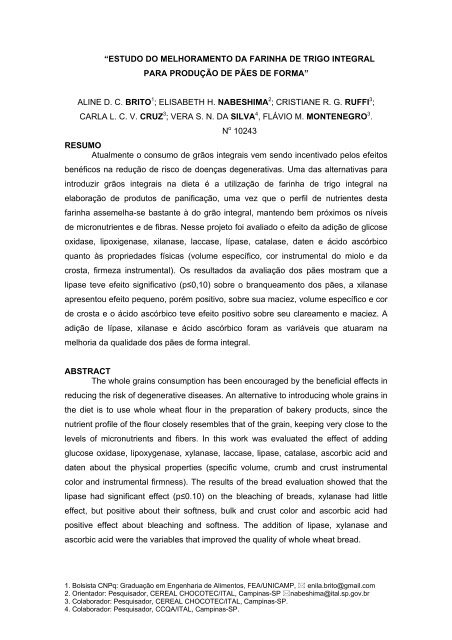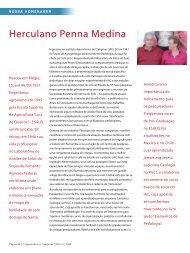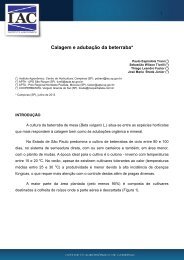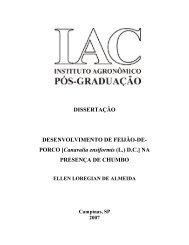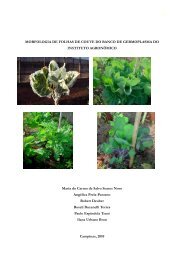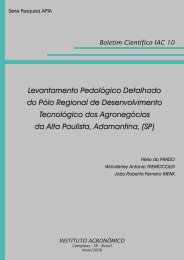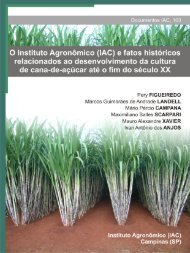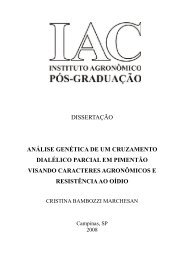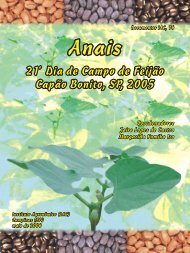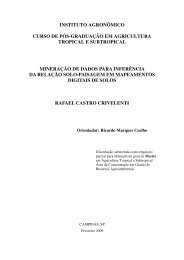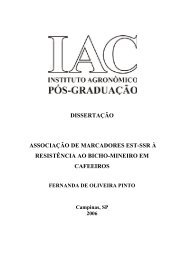estudo do melhoramento da farinha de trigo integral - IAC
estudo do melhoramento da farinha de trigo integral - IAC
estudo do melhoramento da farinha de trigo integral - IAC
You also want an ePaper? Increase the reach of your titles
YUMPU automatically turns print PDFs into web optimized ePapers that Google loves.
“ESTUDO DO MELHORAMENTO DA FARINHA DE TRIGO INTEGRAL<br />
PARA PRODUÇÃO DE PÃES DE FORMA”<br />
ALINE D. C. BRITO 1 ; ELISABETH H. NABESHIMA 2 ; CRISTIANE R. G. RUFFI 3 ;<br />
CARLA L. C. V. CRUZ 3 ; VERA S. N. DA SILVA 4 , FLÁVIO M. MONTENEGRO 3 .<br />
N o 10243<br />
RESUMO<br />
Atualmente o consumo <strong>de</strong> grãos integrais vem sen<strong>do</strong> incentiva<strong>do</strong> pelos efeitos<br />
benéficos na redução <strong>de</strong> risco <strong>de</strong> <strong>do</strong>enças <strong>de</strong>generativas. Uma <strong>da</strong>s alternativas para<br />
introduzir grãos integrais na dieta é a utilização <strong>de</strong> <strong>farinha</strong> <strong>de</strong> <strong>trigo</strong> <strong>integral</strong> na<br />
elaboração <strong>de</strong> produtos <strong>de</strong> panificação, uma vez que o perfil <strong>de</strong> nutrientes <strong>de</strong>sta<br />
<strong>farinha</strong> assemelha-se bastante à <strong>do</strong> grão <strong>integral</strong>, manten<strong>do</strong> bem próximos os níveis<br />
<strong>de</strong> micronutrientes e <strong>de</strong> fibras. Nesse projeto foi avalia<strong>do</strong> o efeito <strong>da</strong> adição <strong>de</strong> glicose<br />
oxi<strong>da</strong>se, lipoxigenase, xilanase, laccase, lípase, catalase, <strong>da</strong>ten e áci<strong>do</strong> ascórbico<br />
quanto às proprie<strong>da</strong><strong>de</strong>s físicas (volume específico, cor instrumental <strong>do</strong> miolo e <strong>da</strong><br />
crosta, firmeza instrumental). Os resulta<strong>do</strong>s <strong>da</strong> avaliação <strong>do</strong>s pães mostram que a<br />
lipase teve efeito significativo (p≤0,10) sobre o branqueamento <strong>do</strong>s pães, a xilanase<br />
apresentou efeito pequeno, porém positivo, sobre sua maciez, volume específico e cor<br />
<strong>de</strong> crosta e o áci<strong>do</strong> ascórbico teve efeito positivo sobre seu clareamento e maciez. A<br />
adição <strong>de</strong> lípase, xilanase e áci<strong>do</strong> ascórbico foram as variáveis que atuaram na<br />
melhoria <strong>da</strong> quali<strong>da</strong><strong>de</strong> <strong>do</strong>s pães <strong>de</strong> forma <strong>integral</strong>.<br />
ABSTRACT<br />
The whole grains consumption has been encouraged by the beneficial effects in<br />
reducing the risk of <strong>de</strong>generative diseases. An alternative to introducing whole grains in<br />
the diet is to use whole wheat flour in the preparation of bakery products, since the<br />
nutrient profile of the flour closely resembles that of the grain, keeping very close to the<br />
levels of micronutrients and fibers. In this work was evaluated the effect of adding<br />
glucose oxi<strong>da</strong>se, lipoxygenase, xylanase, laccase, lipase, catalase, ascorbic acid and<br />
<strong>da</strong>ten about the physical properties (specific volume, crumb and crust instrumental<br />
color and instrumental firmness). The results of the bread evaluation showed that the<br />
lipase had significant effect (p≤0.10) on the bleaching of breads, xylanase had little<br />
effect, but positive about their softness, bulk and crust color and ascorbic acid had<br />
positive effect about bleaching and softness. The addition of lipase, xylanase and<br />
ascorbic acid were the variables that improved the quality of whole wheat bread.<br />
1. Bolsista CNPq: Graduação em Engenharia <strong>de</strong> Alimentos, FEA/UNICAMP, enila.brito@gmail.com<br />
2. Orienta<strong>do</strong>r: Pesquisa<strong>do</strong>r, CEREAL CHOCOTEC/ITAL, Campinas-SP nabeshima@ital.sp.gov.br<br />
3. Colabora<strong>do</strong>r: Pesquisa<strong>do</strong>r, CEREAL CHOCOTEC/ITAL, Campinas-SP.<br />
4. Colabora<strong>do</strong>r: Pesquisa<strong>do</strong>r, CCQA/ITAL, Campinas-SP.
1. INTRODUÇÃO<br />
O consumo <strong>de</strong> grãos integrais vem sen<strong>do</strong> incentiva<strong>do</strong> pelos efeitos benéficos<br />
na redução <strong>de</strong> risco <strong>de</strong> <strong>do</strong>enças <strong>de</strong>generativas, como câncer, diabetes, <strong>do</strong>enças<br />
cardiovasculares e obesi<strong>da</strong><strong>de</strong>. Os grãos são fontes importantes <strong>de</strong> fibras, proteínas,<br />
gorduras, lignanas, minerais (ferro, zinco, cobre e magnésio), vitaminas <strong>do</strong> complexo<br />
B, compostos fenólicos e antioxi<strong>da</strong>ntes, nutrientes presentes principalmente no farelo<br />
e gérmen <strong>de</strong>stes (SLAVIN et al., 2000).<br />
Entretanto, a adição <strong>de</strong> fibras a esses produtos acarreta na diluição <strong>do</strong> glúten,<br />
a qual diminui a retenção <strong>de</strong> gás pelos alvéolos durante o assamento, resultan<strong>do</strong> em<br />
produtos <strong>de</strong> menor aceitação sensorial, principalmente pela redução <strong>do</strong> volume, per<strong>da</strong><br />
<strong>da</strong> maciez <strong>do</strong> miolo, efeitos sobre o sabor e escurecimento <strong>de</strong>stes produtos em<br />
relação aos <strong>de</strong> <strong>farinha</strong> branca (COSTA, 2009).<br />
Atualmente os consumi<strong>do</strong>res estão à procura <strong>de</strong> produtos que não<br />
comprometam a saú<strong>de</strong> ou até promovam benefícios à mesma, <strong>da</strong>n<strong>do</strong> preferência por<br />
alimentos, ingredientes e aditivos naturais (GANDRA et al., 2008), tal como o uso <strong>de</strong><br />
enzimas (BONET et al., 2007).<br />
O objetivo <strong>de</strong>ste trabalho foi estu<strong>da</strong>r o efeito <strong>da</strong> adição <strong>de</strong> glicose-oxi<strong>da</strong>se,<br />
xilanase, catalase, laccase, lípase, <strong>da</strong>tem e áci<strong>do</strong> ascórbico quanto às proprie<strong>da</strong><strong>de</strong>s<br />
físicas <strong>de</strong> pão <strong>de</strong> forma <strong>integral</strong>.<br />
2. MATERIAL E MÉTODOS<br />
− Caracterização <strong>da</strong>s matérias-primas: as <strong>farinha</strong>s <strong>de</strong> <strong>trigo</strong> branca e<br />
<strong>integral</strong> foram analisa<strong>da</strong>s quanto ao teor <strong>de</strong> umi<strong>da</strong><strong>de</strong> pelo méto<strong>do</strong> 44-15A <strong>da</strong> AACC<br />
(2000); granulometria pelo méto<strong>do</strong> 965.22 <strong>da</strong> AOAC (1995) ; Falling Number <strong>de</strong><br />
acor<strong>do</strong> com o méto<strong>do</strong> 56-81B <strong>da</strong> AACC (2000); farinografia pelo méto<strong>do</strong> 54-21 <strong>da</strong><br />
AACC (2000) e cor instrumental (MINOLTA, 2002).<br />
− Processamento <strong>do</strong>s pães <strong>de</strong> forma: os pães foram processa<strong>do</strong>s na<br />
planta-piloto <strong>do</strong> Cereal Chocotec/ITAL, através <strong>do</strong> méto<strong>do</strong> <strong>de</strong> massa direta, sen<strong>do</strong><br />
realiza<strong>da</strong>s as seguintes etapas: mistura <strong>do</strong>s ingredientes e <strong>de</strong>senvolvimento <strong>da</strong><br />
massa, divisão (450g) e boleamento, <strong>de</strong>scanso (15min), mol<strong>da</strong>gem, fermentação<br />
(1h30min), forneamento (25min), acondicionamento em sacos <strong>de</strong> polietileno após<br />
aspersão <strong>de</strong> áci<strong>do</strong> sórbico. A formulação padrão está apresenta<strong>da</strong> na Tabela 1.<br />
− Delineamento Experimental Placket-Burman: para <strong>de</strong>terminar as<br />
variáveis in<strong>de</strong>pen<strong>de</strong>ntes que influenciam na quali<strong>da</strong><strong>de</strong> <strong>do</strong> pão <strong>de</strong> forma <strong>integral</strong> e
<strong>de</strong>terminar os melhores níveis <strong>de</strong> adição foi utiliza<strong>do</strong> um <strong>de</strong>lineamento <strong>do</strong> tipo<br />
Plackett-Burman, com oito variáveis <strong>de</strong> entra<strong>da</strong> e em <strong>do</strong>is níveis.<br />
Tabela 1 - Formulação padrão <strong>do</strong>s pães <strong>de</strong> forma<br />
Ingredientes % 1<br />
Quanti<strong>da</strong><strong>de</strong> (g)<br />
Farinha Trigo 50 2000<br />
Farinha Integral 50 2000<br />
Fermento Biológico 2 80<br />
Sal 2 80<br />
Açúcar 4 160<br />
Vital Glúten 2 80<br />
Propionato <strong>de</strong> Cálcio 0,3 12<br />
Leite em pó 4 160<br />
Gordura 3 120<br />
Emulsificante Datem 0,3 12<br />
Áci<strong>do</strong> Ascórbico 0,008 0,32<br />
Enzima Alfa-amilase 0,0004 0,016<br />
Água 60,0 2400<br />
1<br />
Em relação ao total <strong>da</strong> mistura <strong>de</strong> <strong>farinha</strong> <strong>de</strong> <strong>trigo</strong> branca mais <strong>integral</strong><br />
A Tabela 2 mostra os níveis para ca<strong>da</strong> variável in<strong>de</strong>pen<strong>de</strong>nte estu<strong>da</strong><strong>da</strong>. As<br />
variáveis estu<strong>da</strong><strong>da</strong>s e seus níveis foram escolhi<strong>do</strong>s com base na literatura e<br />
recomen<strong>da</strong>ção <strong>do</strong>s fornece<strong>do</strong>res.<br />
Tabela 2 - Valores <strong>da</strong>s variáveis <strong>do</strong> planejamento <strong>do</strong> tipo Plackett-Burman e seus<br />
respectivos níveis codifica<strong>do</strong>s<br />
Variáveis In<strong>de</strong>pen<strong>de</strong>ntes Códigos -1 +1<br />
Glucose-Oxi<strong>da</strong>se (380GOPU/g) X1 0,01g/100g 0,045g/100g<br />
Xilanase (745 HUP/g) X2 0,01g/100g 0,02g/100g<br />
Lipoxigenase (<strong>farinha</strong> <strong>de</strong> soja) X3 0,2 g/100g 0,55 g/100g<br />
Catalase (25000 CIU/g) X4 0,001g/100g 0,1g/100g<br />
Laccase (1000 LAMU/g) X5 0,001g/100g 0,1g/100g<br />
Lípase (19500 UFLG/g) X6 0,001 g/100g 0,005 g/100g<br />
Daten X7 0,3 g/100g 1 g/100g<br />
Ac. Ascórbico X8 0,005 g/100g 0,04 g/100g<br />
− Caracterização <strong>do</strong>s pães <strong>de</strong> forma: foram realiza<strong>do</strong>s através <strong>da</strong><br />
<strong>de</strong>terminação <strong>de</strong> volume específico (méto<strong>do</strong> <strong>de</strong> <strong>de</strong>slocamento <strong>de</strong> sementes <strong>de</strong> colza<br />
<strong>da</strong> AACC, 2000) após 2 horas <strong>de</strong> resfriamento; análises <strong>de</strong> firmeza instrumental<br />
utilizan<strong>do</strong> texturômetro TAXT2i (méto<strong>do</strong> 74-09 <strong>de</strong> AACC, 2000) e cor instrumental <strong>da</strong><br />
casca e <strong>do</strong> miolo utilizan<strong>do</strong> colorímetro Konica Minolta CR 410 (MINOLTA, 2002).
− Análise estatística: os <strong>da</strong><strong>do</strong>s obti<strong>do</strong>s a partir <strong>do</strong> planejamento<br />
experimental foram analisa<strong>do</strong>s utilizan<strong>do</strong>-se o programa Statistica 5.5 (StatSoft, Inc.,<br />
Tulsa, OK, USA) para a obtenção <strong>do</strong>s efeitos <strong>de</strong> ca<strong>da</strong> variável in<strong>de</strong>pen<strong>de</strong>nte.<br />
4. RESULTADOS E DISCUSSÃO<br />
4.1. Análises Físico-Químicas e Reológicas <strong>da</strong>s Misturas <strong>de</strong> Farinha <strong>de</strong> Trigo<br />
Branca e Integral (1:1)<br />
No farinograma, a mistura <strong>de</strong> <strong>farinha</strong>s branca e <strong>integral</strong> apresentou tempo <strong>de</strong><br />
estabili<strong>da</strong><strong>de</strong> alto (9,5 min.) e ITM médio (60 U.B.), com características <strong>de</strong> uma <strong>farinha</strong><br />
forte, que resiste bem ao tratamento mecânico, tornan<strong>do</strong>-a uma <strong>farinha</strong> a<strong>de</strong>qua<strong>da</strong> para<br />
uso em panificação. Apresentou umi<strong>da</strong><strong>de</strong> (12,39%) <strong>de</strong>ntro <strong>do</strong> limite estabeleci<strong>do</strong> pela<br />
legislação e uma cor (parâmetro L*) <strong>de</strong> 85,15 ± 0,54, intermediário entre a <strong>da</strong> <strong>farinha</strong><br />
branca e a <strong>da</strong> <strong>integral</strong>. Porém, um Falling Number alto, <strong>de</strong> 359,75±13,20,<br />
<strong>de</strong>monstran<strong>do</strong> a necessi<strong>da</strong><strong>de</strong> <strong>de</strong> suplementação com alfa-amilase exógena.<br />
4.2. Análises <strong>de</strong> avaliação <strong>do</strong>s pães <strong>de</strong> forma<br />
Na Tabela 3 estão os resulta<strong>do</strong>s obti<strong>do</strong>s pelas análises e caracterização <strong>de</strong><br />
ca<strong>da</strong> ensaio <strong>do</strong> <strong>de</strong>lineamento Placket-Burmann.<br />
Tabela 3 – Resulta<strong>do</strong>s <strong>de</strong> volume específico, cor <strong>da</strong> crosta e <strong>do</strong> miolo e textura<br />
instrumental <strong>do</strong>s pães <strong>de</strong> forma <strong>integral</strong><br />
Variáveis In<strong>de</strong>pen<strong>de</strong>ntes Respostas<br />
E X1 X2 X3 X4 X5 X6 X7 X8 V.E.<br />
L*<br />
Crosta<br />
a* b* L*<br />
Miolo<br />
a* b*<br />
Firmeza (g.f)<br />
1 dia 12 dia<br />
1 1,8 0,4 22 0,4 0,4 0,4 20 1,6 3,84 39,87 16,06 21,11 68,96 4,53 18,71 130,6 278,7<br />
2 1,8 0,8 8 4 0,4 0,4 4 1,6 3,56 39,65 15,81 21,31 69,11 4,66 18,58 127,5 475,4<br />
3 0,4 40 22 0,4 4 0,4 4 0,2 3,92 36,55 14,75 17,43 66,72 4,90 18,99 125,2 357,7<br />
4 1,8 0,4 22 4 0,4 2 4 0,2 3,19 42,57 16,39 25,04 68,70 4,86 18,03 285,8 647,4<br />
5 1,8 0,8 8 4 4 0,4 20 0,2 2,96 39,34 15,96 21,49 65,08 5,48 18,45 255,9 679,3<br />
6 1,8 0,8 22 0,4 40 2 4 1,6 3,71 36,62 14,98 17,50 66,07 5,04 18,52 166,2 409,4<br />
7 0,4 0,8 22 4 0,4 2 20 0,2 2,87 38,29 16,21 20,51 67,60 5,12 19,22 308,8 651,2<br />
8 0,4 0,4 22 4 4 0,4 20 1,6 2,94 41,49 16,08 23,59 65,63 5,22 18,01 274,8 713,7<br />
9 0,4 0,4 8 4 4 2 4 1,6 3,076 40,76 16,62 22,66 65,92 5,15 18,73 227,2 573,1<br />
10 1,8 0,4 8 0,4 4 2 20 0,2 3,61 40,68 16,83 22,58 64,96 5,20 19,42 139,0 348,5<br />
11 0,4 0,8 8 0,4 0,4 2 20 1,6 3,79 39,22 16,16 20,93 68,58 4,73 18,38 123,0 339,4<br />
12 0,4 0,4 8 0,4 0,4 0,4 4 0,2 3,96 40,57 15,96 22,23 69,57 4,67 19,09 129,4 438,6<br />
X1 = Glicose-Oxi<strong>da</strong>se; X2 = Xilanase; X3 = Lipoxigenase; X4 = Catalase; X5 = Laccase; X6 =<br />
Lipase, X7 = Datem; X8 = Ac. Ascórbico. V.E.= volume específico (cm 3 /g)<br />
A adição <strong>de</strong> ingredientes com alto teor <strong>de</strong> fibras causa a diminuição <strong>do</strong> volume<br />
especifico <strong>do</strong>s produtos <strong>de</strong> panificação (Laurikainem et al. (1997), este fato po<strong>de</strong> ser
observa<strong>do</strong> ao avaliar os resulta<strong>do</strong>s obti<strong>do</strong>s pelos ensaios, que variaram <strong>de</strong> 2,87 a 3,92<br />
cm 3 /g. As variáveis significativas apresentavam efeito negativo sobre a resposta, com<br />
exceção <strong>da</strong> xilanase que apresentou efeito pequeno, porém positivo, sobre a mesma.<br />
Os resulta<strong>do</strong>s estatísticos para os parâmetros L*, a* e b* <strong>de</strong> cor <strong>da</strong> crosta<br />
mostraram que as concentrações <strong>de</strong> lipase e áci<strong>do</strong> ascórbico resultaram em efeito<br />
significativo (p≤0,10) para to<strong>do</strong>s os três parâmetros. O efeito apresenta<strong>do</strong> pela lipase<br />
também foi observa<strong>do</strong> por outros pesquisa<strong>do</strong>res (GÉLINAS et al., 1998). Estes efeitos<br />
po<strong>de</strong>m ser observa<strong>do</strong>s no gráfico <strong>de</strong> Pareto (Figura 1) <strong>do</strong> parâmetro L* <strong>da</strong> cor <strong>da</strong><br />
crosta.<br />
(6)LIP<br />
(8)AC<br />
(3)LIPOX<br />
(1)GO<br />
(4)CAT<br />
(5)LAC<br />
(7)DAT<br />
(2)XIL<br />
Pareto Chart of Stan<strong>da</strong>rdized Effects; Variable: L_CROSTA<br />
8 Factor Screening Design; MS Residual=339,7535<br />
DV: L_CROSTA<br />
p=,1<br />
-1,24178<br />
-1,17413<br />
-1,12338<br />
,923546<br />
-,897235<br />
,8659125<br />
3,100778<br />
-2,94416<br />
0,5 1,0 1,5 2,0 2,5 3,0 3,5<br />
Effect Estimate (Absolute Value)<br />
Figura 1 – Estimativa <strong>do</strong>s efeitos (valor absoluto) <strong>da</strong>s variáveis utiliza<strong>da</strong>s no<br />
planejamento Plackett-Burmann para o parâmetro L* <strong>de</strong> cor <strong>da</strong> crosta.<br />
Já os resulta<strong>do</strong>s estatísticos para os parâmetros L* e a* <strong>da</strong> cor <strong>do</strong> miolo <strong>do</strong>s<br />
pães não apresentaram variáveis com efeito significativo (p≤0,10). Enquanto que para<br />
o parâmetro b* as concentrações <strong>de</strong> lipase e <strong>da</strong>tem obtiveram efeito positivo<br />
significativo (p≤0,10), conforme observa<strong>do</strong> no gráfico <strong>de</strong> Pareto (Figura 2)<br />
(6)LIP<br />
(1)GO<br />
(7)DAT<br />
(5)LAC<br />
(3)LIPOX<br />
(8)AC<br />
(2)XIL<br />
(4)CAT<br />
0,<br />
Pareto Chart of Stan<strong>da</strong>rdized Effects; Variable: B_MIOLO<br />
8 Factor Screening Design; MS Residual=2,444444<br />
DV: B_MIOLO<br />
p=,1<br />
,7385489<br />
-,369274<br />
-2,58492<br />
2,584921<br />
2,215647<br />
-2,21565<br />
4,431294<br />
-0,5 0,0 0,5 1,0 1,5 2,0 2,5 3,0 3,5 4,0 4,5 5,0<br />
Effect Estimate (Absolute Value)<br />
Figura 2 – Estimativa <strong>do</strong>s efeitos (valor absoluto) <strong>da</strong>s variáveis utiliza<strong>da</strong>s no<br />
planejamento Plackett-Burmann para o parâmetro b* <strong>de</strong> cor <strong>do</strong> miolo.
A partir <strong>do</strong>s resulta<strong>do</strong>s <strong>da</strong> firmeza instrumental <strong>do</strong>s pães, observa-se que, com<br />
24h, os pães <strong>da</strong> formulação padrão estavam mais macios que os <strong>do</strong> <strong>de</strong>lineamento<br />
experimental, porém, durante a estocagem, alguns ensaios apresentaram menores<br />
valores <strong>de</strong> firmeza ou mais macios. Po<strong>de</strong>-se verificar, através <strong>da</strong> análise estatística<br />
que a catalase apresentou efeito significativamente positivo sobre a firmeza, enquanto<br />
aci<strong>do</strong> ascórbico, glicose oxi<strong>da</strong>se e xilanase apresentaram efeito não significativo,<br />
porém negativo, sobre a mesma, ou seja, contribuin<strong>do</strong> para a maciez <strong>do</strong>s pães.<br />
5. CONCLUSÃO<br />
A lipase apresentou efeito branquea<strong>do</strong>r sobre os parâmetros <strong>de</strong> cor a*, b* e L*<br />
<strong>da</strong> crosta e <strong>do</strong> miolo.<br />
A xilanase apresentou efeitos pequenos, porém positivos, sobre a maciez, o<br />
volume e a cor <strong>da</strong> crosta.<br />
O áci<strong>do</strong> ascórbico é um reconheci<strong>do</strong> coadjuvante tecnológico e mostrou efeitos<br />
positivos sobre a maciez e a cor, portanto seu nível será fixa<strong>do</strong>.<br />
6. REFERÊNCIAS BIBLIOGRÁFICAS<br />
AACC. AMERICAN ASSOCIATION OF CEREAL CHEMISTS. Approved Methods,<br />
10th ed., St. Paul: AACC, 2000. AACC.<br />
BONET, A.; ROSELL, C.M.; PÉREZ-MUNUERA, I.; HERNANDO, I. Rebuilding gluten<br />
network of <strong>da</strong>maged wheat by means of glucose oxi<strong>da</strong>se treatment. Journal of<br />
Science and Food Agriculture, v.81, p.1301-1307, 2007.<br />
COSTA, P. F. P.; CHANG, Y. K. Efeito <strong>da</strong> radiação gama e <strong>da</strong> radiação<br />
infavermelha na vi<strong>da</strong> <strong>de</strong> prateleira e nas características tecnológicas <strong>da</strong> <strong>farinha</strong><br />
<strong>de</strong> <strong>trigo</strong> <strong>integral</strong> e <strong>do</strong> pão <strong>de</strong> forma <strong>integral</strong>. Tese <strong>de</strong> Mestra<strong>do</strong>. Facul<strong>da</strong><strong>de</strong> <strong>de</strong><br />
Engenharia <strong>de</strong> Alimentos. UNICAMP. 2009.<br />
GANDRA, K.M.; DEL BIANCHI, M.; GODOY, V.P., QUEIROZ, F.P.C.; STEEL, C.J.<br />
Aplicação <strong>de</strong> lipase e monoglicerí<strong>de</strong>os em pão <strong>de</strong> forma enriqueci<strong>do</strong> com fibras.<br />
Ciência e Tecnologia <strong>de</strong> Alimentos, Campinas v.28, n.1, p.182-192, jan-mar 2008.<br />
LAURIKAINEN, T.; HARKONEN, H.; AUTIO, K.; POUTANEN, K. Effects of enzymes<br />
in fibre-enriched baking. Journal of Science and Food Agriculture, v.76, p.239-249,<br />
1998.<br />
MINOLTA. User Manual: Chroma Meter Mo<strong>de</strong>lo CR 410. New Jersey: Konica<br />
Minolta, 2002.<br />
STATISTICA for win<strong>do</strong>ws – Release 5.5 A. StatSoft, Inc. Tulsa, OK, USA, 1995.<br />
7. AGRADECIMENTOS<br />
Ao CNPQ – PIBIC.


